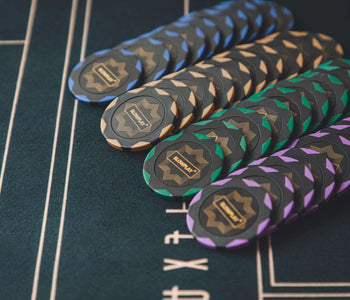THE ESSENTIAL GUIDE TO POKER MATH

#Pokermath #Math and Poker #Poker Strategy #Poker Mathematics
Is poker a game of skill or pure luck? This question resulted in extensive and profound discussions in North America 15 years ago, because the answer directly affected the legalization process of online poker in North American countries.
The answer lies in the math behind the poker games. If the statistical results prove that some players have a significantly higher probability of winning than other players, then poker is a game of skill.
Before we continue, let’s go over a few facts:
#1. In Texas Hold'em, 52 cards are used, including 4 suits and 13 points. In other words, we have clubs (♣), diamonds (♦), hearts (♥), and spades (♠). Each suit includes an Ace, a King, Queen and Jack, while numerals range from the Deuce (Two) to the Ten.
#2. Each player changes their relative position as frequently as the other players. In other words, everyone will take turns playing as the small blind, big blind, UTG, etc. Due to differences in time or other situations such as someone leaving their seat during the game, the frequency may not be 100% equal for everyone, but it remains roughly the same.
#3. The rules of the poker game and the venue are not biased and every player present obeys the same set of rules.
#4. Regardless of other factors, if all five community cards are dealt, the possibility of winning with a leading starting hand will be much higher than that of weaker starting hands. This has been proven through millions of computer simulations.

Why Poker Math Matters?
It is important because the game is fair to every player, presenting everyone with an equal chance of winning. By understanding poker math, you can improve your chance of winning through your skills.
In the Texas Hold'em game, there are thousands of possibilities for each hand. You only need to know that all possible results are based on a limited combination of 52 cards.
For Example: Your starting hand is AA, and you know that there are two Aces in the remaining 50 cards. Among the remaining 48 cards, there are 4 suits and 12 cards smaller than Aces. You don't have any information about where these cards are before the flop, but you will gradually get more information as the game progresses.
#Pokermath #Math and Poker #Poker Strategy #Poker Mathematics
Moving on, when the flop shows you A44, you now have a full house. You also know that only a hand with four 4s that can beats you here. Since there are already two 4s on the table, the probability that your opponent holds the other two 4s is 1 in 1326. This probability is too low, so every time you encounter this situation, you should treat your card as a nut hand.
How do we get the probability of 1 in 1326?
Think this way: Get 2 cards out of 52 cards at random, and the probability of each specific combination is 1 in 1326. The first card you get can be any of the two 4s, which is 2 out of 52, and the second card is the probability that the remaining one will appear in the remaining 51 cards, which is 1 in 51. The multiplication results in 1 in 1326, which is our answer.

Poker Math: Basic and Practical
Many beginners have a misunderstanding about poker mathematics, thinking that basic knowledge is the answer or conclusion. They tend to think that they can't perform complex calculations in the game, so they simply don't learn it, or just follow the math results to play the game.
Let's put it this way, the basic knowledge of poker math should be the basis of your strategy. Under the table, it should be the theoretical basis for your when you construct or review your game strategies. The general logic is this: after you learn about poker math, practice and verify what you learn during games then build your own set of self-consistent strategies, execute them in the games, and keep verifying and modifying your strategy back and forth to improve your skills.
This is the most basic element in poker games. We have already said that some starting hands are more advantageous.
This also means that in your first poker math lesson, you should learn the starting hand first. Entering the game when you hold stronger starting hand could win you the first advantage.
If you don't remember anything after reading this article, at least remember this: tightening your hand range can also significantly improve your game results.
That being said, we have prepared a sheet for you so you can have a rough idea:


Advanced Poker Math
Upon hearing the poker math terms like “expected value”, many beginners instinctively feel resistant. However, the truth is there is no need to overly estimate its complexity.
After all, playing poker is not doing scientific research. We just use mathematical knowledge to make decisions, and you don’t need to make complicated calculations at the poker table.
All you need is to study and understand the principles. Most of the time, you accumulate experience based on what you learn and your poker strategies at the table until you form a subconscious reaction.
Expected Value:
In short, it means that in hundreds of games, some result will appear on average a certain number of times. When you know what your expected value is, in the long run, it will be reflected in your results.
The goal of the game is to make as many decisions with high EV as possible, while minimizing or completely avoiding decisions with low EV.
Almost all actions in a poker game have their expected value, and only a few elements depend on the situation.
• If most people at the table are stronger than you, then overall this is a scenario of negative expected value.
• If most people at the table are weaker than you, then overall this is a positive expected value scenario and you will win a lot in the long run.
But the problem is that you can't know who is strong and who is not, at the minute you sit down at the table. Certain scenarios in the game are easier to judge the expected value, while there is also less obvious information, unless you systematically study and observe your opponents for a certain period of time, otherwise they remain very uncertain for you.
If you do not have a systematic and comprehensive study and training, you would have to classify your own experiences so that next time you encounter a similar situation, you could generally remind yourself whether the current situation is beneficial to you.
Let me explain to you how to judge your current expectations through a few examples.
Example 1:
You are on the turn now. Your opponent's about to bet and you are only one card short of hitting a flush. The pot is $400 and your opponent bets $100.
You can't see the river if you don't call the $100. When you lose you lose $100, when you win you get $600 back. This includes: the $100 you called, the original $400 in the pot along with the $100 your opponent bet.
Many beginners will confuse one thing that they think the pot still have their own input before the turn. But whenever you face a decision, you should calculate its expected value independently. Once all the chips are put into the pot, they don't belong to anyone, collectively they are called "dead money."
If this situation happens multiple times, you may win several times on average. For the convenience of calculations, we use 100 times in this example .
In this case, you can win 9 times out of 46 times. This means that 19.56% of the winning rate, 80.44% of the probability of losing, approximately equal to 20% and 80%.
If you invest $100, when this situation happens 100 times your cost sums up to $10,000. You lose 80 times without any benefit. But you would win the other 20 times, in which you would get back 20 times $600, which comes up to $12,000. In other words, you make $2000 in total for these 100 times. An average of $20 each time.
In fact, you will win more than this because we have not yet counted the river moves. Maybe after hitting, sometimes the opponent doesn't believe it and will pay you more.
Example 2:
Assume the same situation above happens but this time you have made a straight and your opponent is going to make a flush. The river card has been dealt, the pot is $600, and there are three cards of the same suit among the community cards now.
The opponent bets $20 this time. If he hits a flush, then he is going to win. Even in this case you still need to call. Do you know why?
You have to call because you cannot be 100% sure that your opponent hits a flush. They may also be bluffing or overestimating their hands, or some strategic betting defense, while your straight hand leads in these situations.
Let's see what poker math says.
If you do this 100 times, your total investment becomes 20 times $100, or $2000.
You win and you get $640, including the original $600 in the pot, $20 from your opponent, and $20 from your call. We have already won $1920 by winning only 3 times, covering almost all the cost of 100 times.
You only need to win 4 times to start profiting. This is a positive expected value scenario because after wining 4 times you reclaimed $2560, you won $560, which means you win $5.6 every game.
In other words, even if your opponent bluffs only 4 times out of 100 times, and you lose 96 times out of 100, it is still profitable for you to call.
On the river, the larger your opponent's bet, the higher the probability that you would want him to bluff. Then you need to collect relevant information about your opponent to determine his characteristics in order to determine the positive or negative of your current decision-making expected value.
You can try to look at all the cards you have played in the past thinking about their expected value. It will be a bit slow at first, but after a few times you will become more and more proficient, and you can even see it at a glance.

To Sum Up
#Pokermath #Math and Poker #Poker Strategy #Poker Mathematics
In the past ten years of continuous development and evolution of Texas Hold'em game strategy, it can be said that the winning players and the losing players are determined by poker math. Experience is important, but why not spend some time to learn some basic poker math knowledge? It can even help you in work and life. Hopefully this article can be a stepping stone that leads you to more advanced poker skills.
Allen W - Mar 01 2021
Enjoy Elevated Poker Games - Shop Now




